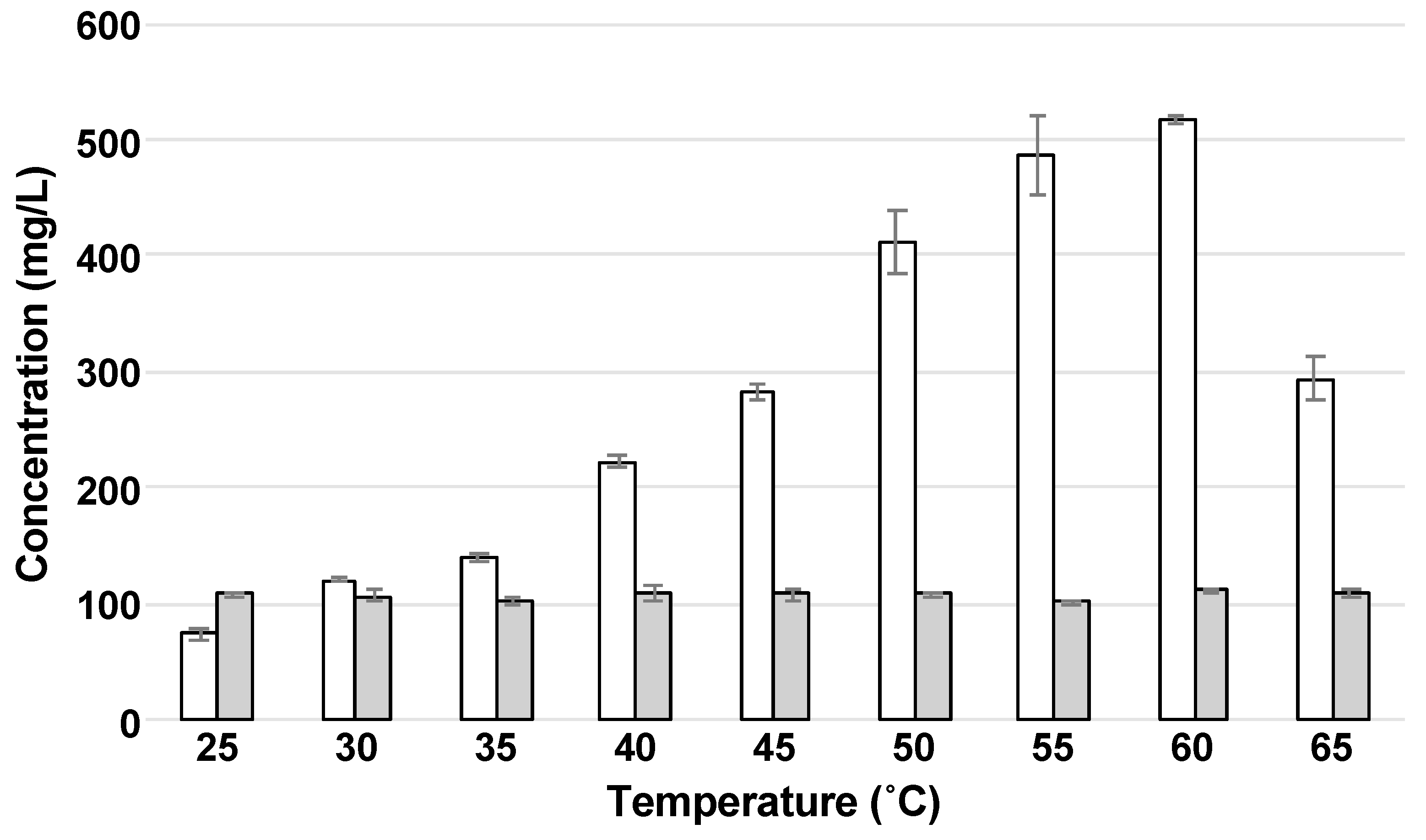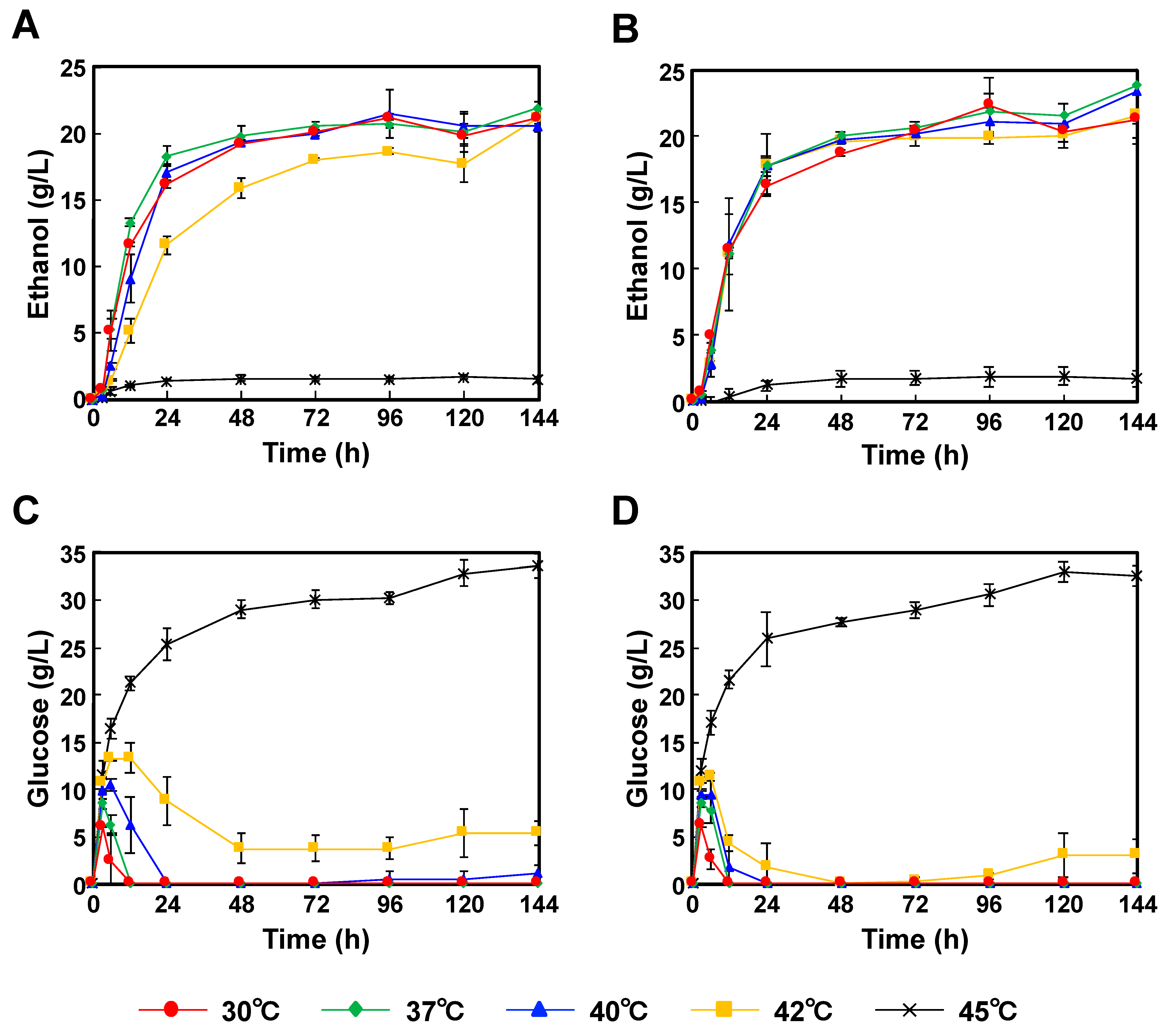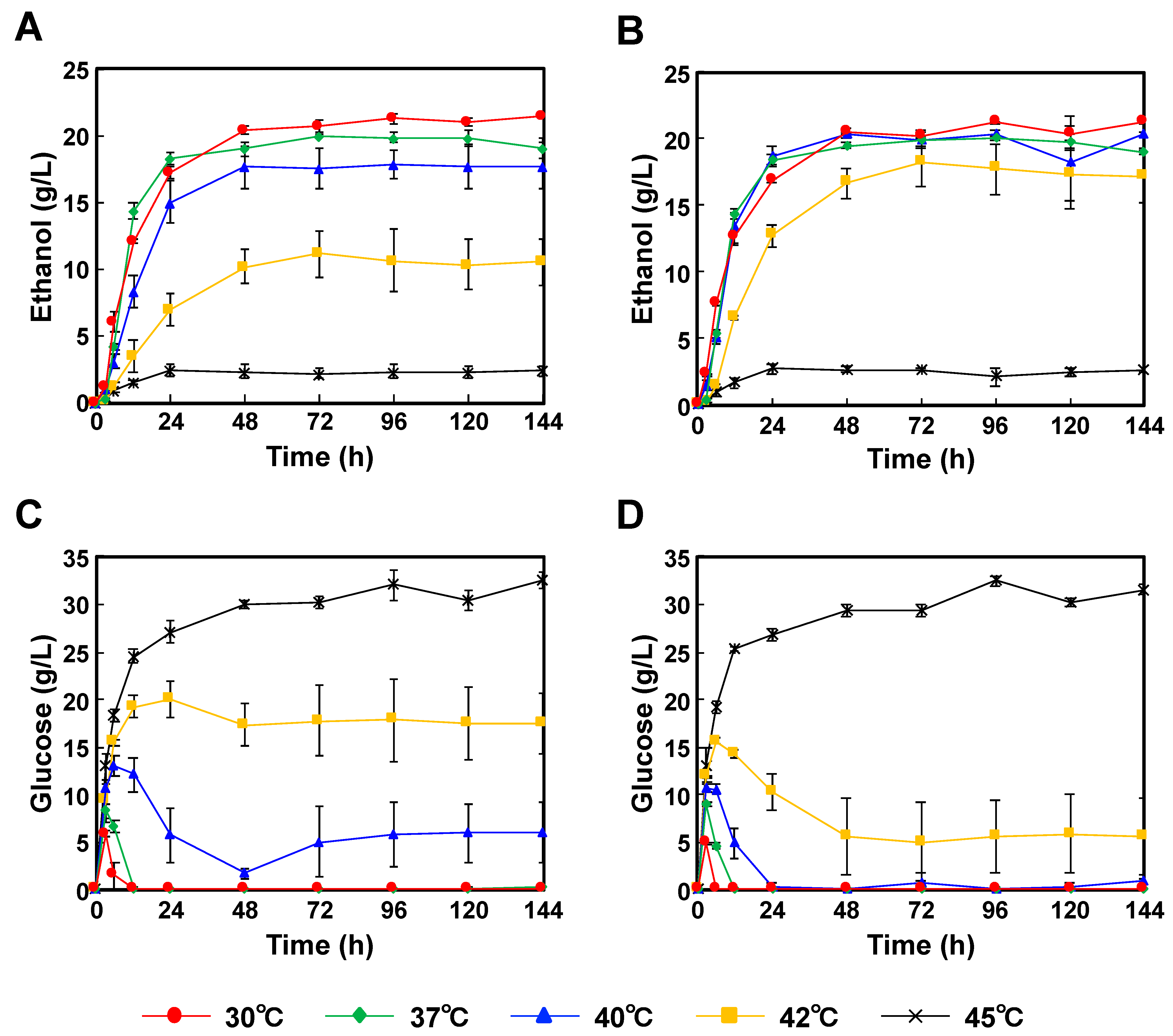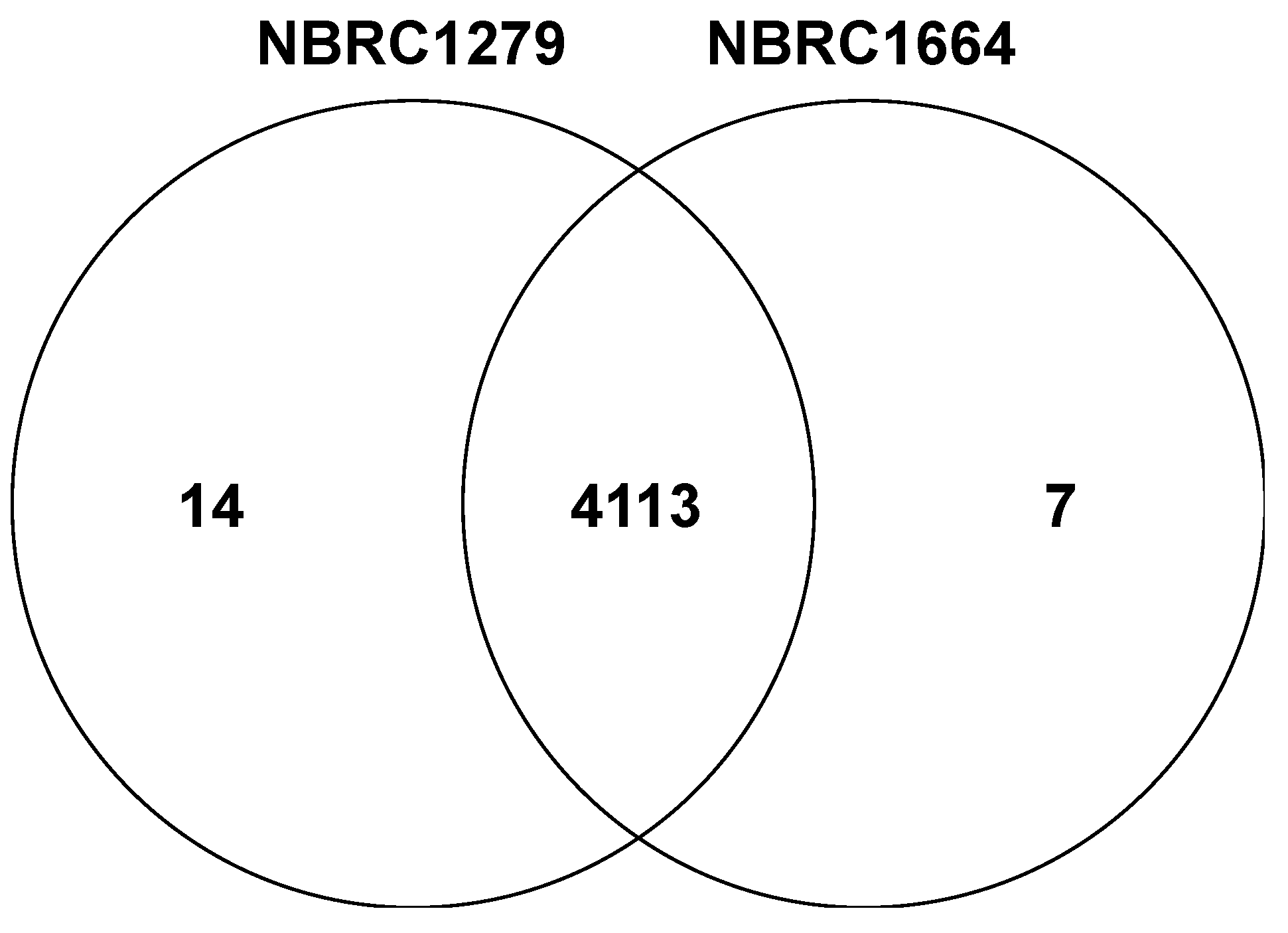Application of Pichia kudriavzevii NBRC1279 and NBRC1664 to Simultaneous Saccharification and Fermentation for Bioethanol Production
Abstract
:1. Introduction
2. Materials and Methods
2.1. Effect of Temperature on Enzymatic Hydrolysis of Cellulose and Hemicellulose
2.2. Simultaneous Saccharification and Fermentation using P. kudriavzevii NBRC1279 and NBRC1664
2.3. Quantification of Ethanol and Sugars
2.4. Genomic DNA Preparation
2.5. Genome Sequencing
2.6. Genome Assembly, Annotation, and Comparison
3. Results and Discussion
3.1. Use of Optimash BG and Acremonium Cellulase for the Enzymatic Hydrolysis of Cellulose and Hemicellulose
3.2. Application of P. kudriavzevii NBRC1279 and NBRC1664 to SSF for Bioethanol Production
3.3. Difference in P. kudriavzevii NBRC1279 and NBRC1664 Based on Draft Genome Sequences
3.4. Genome Properties for Ethanol Tolerance
4. Conclusions
Supplementary Materials
Author Contributions
Funding
Institutional Review Board Statement
Informed Consent Statement
Data Availability Statement
Acknowledgments
Conflicts of Interest
References
- REN21. Renewables 2017 Global Status Report; Renewable Energy Policy Network for the 21st Century: Paris, France, 2017; pp. 28–39. [Google Scholar]
- Rosales-Calderon, O.; Arantes, V. A review on commercial-scale high-value products that can be produced alongside cellulosic ethanol. Biotechnol. Biofuels 2019, 12, 240. [Google Scholar] [CrossRef] [PubMed] [Green Version]
- Branco, R.H.R.; Serafim, L.S.; Xavier, A.M.R.B. Second generation bioethanol production: On the use of pulp and paper industry wastes as feedstock. Fermentation 2019, 5, 4. [Google Scholar] [CrossRef] [Green Version]
- Robak, K.; Balcerek, M. Review of second generation bioethanol production from residual biomass. Food Technol. Biotechnol. 2018, 56, 174–187. [Google Scholar] [CrossRef] [PubMed]
- Boidin, J.; Pignal, M.C.; Besson, M. Le genre Pichia sensu lato (Deuxième Contribution). Bull. Soc. Mycol. France 1965, 81, 566–606. [Google Scholar]
- Kurtzman, C.P.; Robnett, C.J.; Basehoar-Powers, E. Phylogenetic relationships among species of Pichia, Issatchenkia and Williopsis determined from multigene sequence analysis, and the proposal of Barnettozyma gen. nov., Lindnera gen. nov. and Wickerhamomyces gen. nov. FEMS Yeast Res. 2008, 8, 939–954. [Google Scholar] [CrossRef] [Green Version]
- Yuan, S.F.; Guo, G.L.; Hwang, W.S. Ethanol production from dilute-acid steam exploded lignocellulosic feedstocks using an isolated multistress-tolerant Pichia kudriavzevii strain. Microb. Biotechnol. 2017, 10, 1581–1590. [Google Scholar] [CrossRef]
- Oberoi, H.S.; Babbar, N.; Sandhu, S.K.; Dhaliwal, S.S.; Kaur, U.; Chadha, B.S.; Bhargav, V.K. Ethanol production from alkali-treated rice straw via simultaneous saccharification and fermentation using newly isolated thermotolerant Pichia kudriavzevii HOP-1. J. Ind. Microbiol. Biotechnol. 2012, 39, 557–566. [Google Scholar] [CrossRef]
- Chin, C.S.; Alexander, D.H.; Marks, P.; Klammer, A.A.; Drake, J.; Heiner, C.; Clum, A.; Copeland, A.; Huddleston, J.; Eichler, E.E.; et al. Nonhybrid, finished microbial genome assemblies from long-read SMRT sequencing data. Nat. Methods 2013, 10, 563–569. [Google Scholar] [CrossRef]
- Holt, C.; Yandell, M. MAKER2: An annotation pipeline and genome-database management tool for second-generation genome projects. BMC Bioinform. 2011, 12, 491. [Google Scholar] [CrossRef] [Green Version]
- Stanke, M.; Diekhans, M.; Baertsch, R.; Haussler, D. Using native and syntenically mapped cDNA alignments to improve de novo gene finding. Bioinformatics 2008, 24, 637–644. [Google Scholar] [CrossRef] [Green Version]
- Altschul, S.F.; Gish, W.; Miller, W.; Myers, E.W.; Lipman, D.J. Basic local alignment search tool. J. Mol. Biol. 1990, 215, 403–410. [Google Scholar] [CrossRef]
- Lowe, T.M.; Eddy, S.R. tRNAscan-SE: A program for improved detection of transfer RNA genes in genomic sequence. Nucleic Acids Res. 1997, 25, 955–964. [Google Scholar] [CrossRef]
- Xu, L.; Dong, Z.; Fang, L.; Luo, Y.; Wei, Z.; Guo, H.; Zhang, G.; Gu, Y.Q.; Coleman-Derr, D.; Xia, Q.; et al. OrthoVenn2: A web server for whole-genome comparison and annotation of orthologous clusters across multiple species. Nucleic Acids Res. 2019, 47, W52–W58. [Google Scholar] [CrossRef] [Green Version]
- Pitson, S.M.; Seviour, R.J.; McDougall, B.M.; Woodward, J.R.; Stone, B.A. Purification and characterization of three extracellular (1→3)-β-D-glucan glucohydrolases from the filamentous fungus Acremonium persicinum. Biochem. J. 1995, 308, 733–741, Jayus. [Google Scholar] [CrossRef]
- McDougall, B.M.; Seviour, R.J. Purification and characterization of the (1→3)-β-glucanases from Acremonium sp. IMI 383068. FEMS Microbiol. Lett. 2004, 230, 259–264. [Google Scholar]
- Ono, Y.; Nakamura, Y.; Zhou, Y.; Horikawa, Y.; Isogai, A. Linear and branched structures present in high-molar-mass fractions in holocelluloses prepared from chara, haircap moss, adiantum, ginkgo, Japanese cedar, and eucalyptusLinear and branched structures present in high-molar-mass fractions in holocelluloses prepared from chara, haircap moss, adiantum, ginkgo, Japanese cedar, and eucalyptus. Cellulose 2021, in press. [Google Scholar]
- Gancedo, J.M. Yeast carbon catabolite repression. Microbiol. Mol. Biol. Rev. 1998, 62, 334–361. [Google Scholar] [CrossRef] [Green Version]
- Fujimoto, S.; Inoue, S.; Yoshida, M. High solid concentrations during the hydrothermal pretreatment of eucalyptus accelerate hemicellulose decomposition and subsequent enzymatic glucose production. Bioresour. Technol. Rep. 2018, 4, 16–20. [Google Scholar] [CrossRef]
- Goshima, T.; Tsuji, M.; Inoue, H.; Yano, S.; Hoshino, T.; Matsushika, A. Bioethanol production from Lignocellulosic biomass by a novel Kluyveromyces marxianus strain. Biosci. Biotechnol. Biochem. 2013, 77, 1505–1510. [Google Scholar] [CrossRef] [Green Version]
- Fujii, T.; Murakami, K.; Endo, T.; Fujimoto, S.; Minowa, T.; Matsushika, A.; Yano, S.; Sawayama, S. Bench-scale bioethanol production from eucalyptus by high solid saccharification and glucose/xylose fermentation method. Bioprocess Biosyst. Eng. 2014, 37, 749–754. [Google Scholar] [CrossRef] [Green Version]
- Wang, M.; Zou, Z.; Li, Q.; Xin, H.; Zhu, X.; Chen, X.; Li, X. Heterologous expression of three Camellia sinensis small heat shock protein genes confers temperature stress tolerance in yeast and Arabidopsis thaliana. Plant Cell Rep. 2017, 36, 1125–1135. [Google Scholar] [CrossRef]
- Guo, L.M.; Li, J.; He, J.; Liu, H.; Zhang, H.M. A class I cytosolic HSP20 of rice enhances heat and salt tolerance in different organisms. Sci. Rep. 2020, 10, 1383. [Google Scholar] [CrossRef]
- Feng, G.; Leem, Y.E.; Levin, H.L. Transposon integration enhances expression of stress response genes. Nucleic Acids Res. 2013, 41, 775–789. [Google Scholar] [CrossRef] [Green Version]
- Esnault, C.; Lee, M.; Ham, C.; Levin, H.L. Transposable element insertions in fission yeast drive adaptation to environmental stress. Genome Res. 2019, 29, 85–95. [Google Scholar] [CrossRef] [Green Version]
- Navarro-Tapia, E.; Nana, R.K.; Querol, A.; Pérez-Torrado, R. Ethanol cellular defense induce unfolded protein response in yeast. Front. Microbiol. 2016, 7, 189. [Google Scholar] [CrossRef]
- Matsushika, A.; Negi, K.; Suzuki, T.; Goshima, T.; Hoshino, T. Identification and characterization of a novel Issatchenkia orientalis GPI-anchored protein, IoGas1, is required for resistance to low pH and salt stress. PLoS ONE 2016, 11, e0161888. [Google Scholar] [CrossRef]
- Wada, K.; Fujii, T.; Akita, H.; Matsushika, A. IoGAS1, a GPI-anchored protein derived from Issatchenkia orientalis, confers tolerance of Saccharomyces cerevisiae to multiple acids. Appl. Biochem. Biotechnol. 2019, 190, 1349–1359. [Google Scholar] [CrossRef]
- Auesukaree, C.; Koedrith, P.; Saenpayavai, P.; Asvarak, T.; Benjaphokee, S.; Sugiyama, M.; Kaneko, Y.; Harashima, S.; Boonchird, C. Characterization and gene expression profiles of thermotolerant Saccharomyces cerevisiae isolates from Thai fruits. J. Biosci. Bioeng. 2012, 114, 144–149. [Google Scholar] [CrossRef]
- Zhang, Q.; Wu, D.; Lin, Y.; Wang, X.; Kong, H.; Tanaka, S. Substrate and product inhibition on yeast performance in ethanol fermentation. Energy Fuels 2015, 29, 1019–1027. [Google Scholar] [CrossRef]
- Alkasrawi, M.; Galbe, M.; Zacchi, G. Recirculation of process streams in fuel ethanol production from softwood based on simultaneous saccharification and fermentation. Appl. Biochem. Biotechnol. 2002, 98, 849–861. [Google Scholar] [CrossRef]
- Shui, W.; Xiong, Y.; Xiao, W.; Qi, X.; Zhang, Y.; Lin, Y.; Guo, Y.; Zhang, Z.; Wang, Q.; Ma, Y. Understanding the mechanism of thermotolerance distinct from heat shock response through proteomic analysis of industrial strains of Saccharomyces cerevisiae. Mol. Cell Proteom. 2015, 14, 885–897. [Google Scholar] [CrossRef] [PubMed] [Green Version]
- Xiao, W.; Duan, X.; Lin, Y.; Cao, Q.; Li, S.; Guo, Y.; Gan, Y.; Qi, X.; Zhou, Y.; Guo, L.; et al. Distinct proteome remodeling of industrial Saccharomyces cerevisiae in response to prolonged thermal stress or transient heat shock. J. Proteome Res. 2018, 17, 1812–1825. [Google Scholar] [CrossRef] [PubMed]
- Jhariya, U.; Dafale, N.A.; Srivastava, S.; Bhende, R.S.; Kapley, A.; Purohit, H.J. Understanding ethanol tolerance mechanism in Saccharomyces cerevisiae to enhance the bioethanol production: Current and future prospects. Bioenerg. Res. 2021, 14, 670–688. [Google Scholar] [CrossRef]
- Miao, Y.; Xiong, G.; Li, R.; Wu, Z.; Zhang, X.; Weng, P. Transcriptome profiling of Issatchenkia orientalis under ethanol stress. AMB Express 2018, 8, 39. [Google Scholar] [CrossRef]




| Temperature (°C) | Glucose Productivity [mg/(L·min)] |
|---|---|
| 25 | 1.24 ± 0.08 |
| 30 | 2.01 ± 0.04 |
| 35 | 2.33 ± 0.08 |
| 40 | 3.69 ± 0.09 |
| 45 | 4.69 ± 0.12 |
| 50 | 6.86 ± 0.45 |
| 55 | 8.10 ± 0.59 |
| 60 | 8.62 ± 0.05 |
| 65 | 4.89 ± 0.31 |
| Strain | Source Material | Pretreatment Method | Culture Temperature(°C) | Concentration(g/L) | Productivity [(g/(L·h)] | Reference |
|---|---|---|---|---|---|---|
| P. kudriavzevii HOP-1 | Rice straw | Alkali treatment | 40 | 24.3 | 1.10 | [8] |
| P. kudriavzevii SI | Rice straw | AISE | 42 | 33.4 | 1.07 | [7] |
| P. kudriavzevii NBRC1279 | Japanese cedar | - | 35 | 21.9 | 0.76 * | This study |
| P. kudriavzevii NBRC1279 | Japanese eucalyptus | - | 30 | 21.6 | 0.72 * | This study |
| P. kudriavzevii NBRC1664 | Japanese cedar | - | 35 | 23.8 | 0.74 * | This study |
| P. kudriavzevii NBRC1664 | Japanese eucalyptus | - | 30 | 21.3 | 0.70 * | This study |
| Properties | NBRC1279 | NBRC1664 |
|---|---|---|
| Genome length (bp) | 12,851,201 | 12,362,690 |
| GC content (%) | 37.6 | 37.8 |
| Contig numbers | 79 | 76 |
| Coding sequence numbers | 4897 | 4815 |
| tRNA | 460 | 341 |
| NBRC1279 | NBRC1664 | ||||
|---|---|---|---|---|---|
| Class | Description | Count | Proportion (%) | Count | Proportion (%) |
| Information storage and processing | |||||
| J | Translation, ribosomal structure, and biogenesis | 345 | 8.54 | 349 | 8.85 |
| A | RNA processing and modification | 54 | 1.34 | 50 | 1.27 |
| K | Transcription | 237 | 5.87 | 235 | 5.96 |
| L | Replication, recombination, and repair | 241 | 5.97 | 208 | 5.27 |
| B | Chromatin structure and dynamics | 39 | 0.97 | 40 | 1.01 |
| Cellular processes and signaling | |||||
| D | Cell cycle control, cell division, chromosome partitioning | 36 | 0.89 | 38 | 0.96 |
| Y | Nuclear structure | 0 | 0.00 | 0 | 0.00 |
| V | Defense mechanisms | 33 | 0.82 | 37 | 0.94 |
| T | Signal transduction mechanisms | 171 | 4.23 | 176 | 4.46 |
| M | Cell wall/membrane/envelope biogenesis | 45 | 1.11 | 47 | 1.19 |
| N | Cell motility | 7 | 0.17 | 5 | 0.13 |
| Z | Cytoskeleton | 55 | 1.36 | 55 | 1.39 |
| W | Extracellular structures | 0 | 0.00 | 0 | 0.00 |
| U | Intracellular trafficking, secretion, and vesicular transport | 306 | 7.57 | 297 | 7.53 |
| O | Posttranslational modification, protein turnover, chaperones | 330 | 8.17 | 337 | 8.54 |
| Metabolism | |||||
| C | Energy production and conversion | 195 | 4.83 | 172 | 4.36 |
| G | Carbohydrate transport and metabolism | 158 | 3.91 | 152 | 3.85 |
| E | Amino acid transport and metabolism | 205 | 5.07 | 205 | 5.20 |
| F | Nucleotide transport and metabolism | 71 | 1.76 | 68 | 1.72 |
| H | Coenzyme transport and metabolism | 93 | 2.30 | 86 | 2.18 |
| I | Lipid transport and metabolism | 104 | 2.57 | 100 | 2.54 |
| P | Inorganic ion transport and metabolism | 99 | 2.45 | 98 | 2.48 |
| Q | Secondary metabolites biosynthesis, transport, and catabolism | 43 | 1.06 | 47 | 1.19 |
| Poorly characterized | |||||
| R | General function prediction only | 479 | 11.86 | 469 | 11.89 |
| S | Function unknown | 694 | 17.18 | 673 | 17.06 |
| NBRC1279 | NBRC1664 |
|---|---|
| Aldo/keto reductase family protein | Cytochrome c oxidase subunit 2 |
| Leptin receptor gene-related protein | Hmra1p |
| Molecular chaperones HSP70/HSC70 | Metalloendoprotease HMP1 |
| Monocarboxylate transporter | NADH dehydrogenase subunits 2, 5, and related proteins |
| Peptide methionine sulfoxide reductase | Phenylalanyl-tRNA synthetase, β-subunit |
| Predicted transporter | Phospholipase |
| Retrotransposon protein1 | Uncharacterized conserved protein |
| Retrotransposon protein2 | |
| Retrotransposon protein3 | |
| Retrotransposon protein4 | |
| Retrotransposon protein5 | |
| Solute carrier family 25 | |
| Ubiquitin-conjugating enzyme E2 | |
| Uncharacterized protein |
Publisher’s Note: MDPI stays neutral with regard to jurisdictional claims in published maps and institutional affiliations. |
© 2021 by the authors. Licensee MDPI, Basel, Switzerland. This article is an open access article distributed under the terms and conditions of the Creative Commons Attribution (CC BY) license (https://creativecommons.org/licenses/by/4.0/).
Share and Cite
Akita, H.; Goshima, T.; Suzuki, T.; Itoiri, Y.; Kimura, Z.-i.; Matsushika, A. Application of Pichia kudriavzevii NBRC1279 and NBRC1664 to Simultaneous Saccharification and Fermentation for Bioethanol Production. Fermentation 2021, 7, 83. https://doi.org/10.3390/fermentation7020083
Akita H, Goshima T, Suzuki T, Itoiri Y, Kimura Z-i, Matsushika A. Application of Pichia kudriavzevii NBRC1279 and NBRC1664 to Simultaneous Saccharification and Fermentation for Bioethanol Production. Fermentation. 2021; 7(2):83. https://doi.org/10.3390/fermentation7020083
Chicago/Turabian StyleAkita, Hironaga, Tetsuya Goshima, Toshihiro Suzuki, Yuya Itoiri, Zen-ichiro Kimura, and Akinori Matsushika. 2021. "Application of Pichia kudriavzevii NBRC1279 and NBRC1664 to Simultaneous Saccharification and Fermentation for Bioethanol Production" Fermentation 7, no. 2: 83. https://doi.org/10.3390/fermentation7020083
APA StyleAkita, H., Goshima, T., Suzuki, T., Itoiri, Y., Kimura, Z.-i., & Matsushika, A. (2021). Application of Pichia kudriavzevii NBRC1279 and NBRC1664 to Simultaneous Saccharification and Fermentation for Bioethanol Production. Fermentation, 7(2), 83. https://doi.org/10.3390/fermentation7020083






